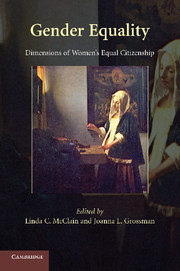Book contents
- Frontmatter
- Contents
- Contributors
- Acknowledgments
- Gender Equality
- Introduction
- PART I CONSTITUTIONAL CITIZENSHIP AND GENDER
- 1 Gender at the Margins of Contemporary Constitutional Citizenship
- 2 Becoming a Citizen: Marriage, Immigration, and Assimilation
- 3 Women's Civic Inclusion and the Bill of Rights
- 4 Must Feminists Identify as Secular Citizens? Lessons From Ontario
- 5 Feminist Fundamentalism and Constitutional Citizenship
- PART II POLITICAL CITIZENSHIP AND GENDER
- PART III SOCIAL CITIZENSHIP AND GENDER
- PART IV SEXUAL AND REPRODUCTIVE CITIZENSHIP
- PART V GLOBAL CITIZENSHIP AND GENDER
- Suggested Readings
- Index
- References
3 - Women's Civic Inclusion and the Bill of Rights
Published online by Cambridge University Press: 05 August 2012
- Frontmatter
- Contents
- Contributors
- Acknowledgments
- Gender Equality
- Introduction
- PART I CONSTITUTIONAL CITIZENSHIP AND GENDER
- 1 Gender at the Margins of Contemporary Constitutional Citizenship
- 2 Becoming a Citizen: Marriage, Immigration, and Assimilation
- 3 Women's Civic Inclusion and the Bill of Rights
- 4 Must Feminists Identify as Secular Citizens? Lessons From Ontario
- 5 Feminist Fundamentalism and Constitutional Citizenship
- PART II POLITICAL CITIZENSHIP AND GENDER
- PART III SOCIAL CITIZENSHIP AND GENDER
- PART IV SEXUAL AND REPRODUCTIVE CITIZENSHIP
- PART V GLOBAL CITIZENSHIP AND GENDER
- Suggested Readings
- Index
- References
Summary
The Bill of Rights is often treated as the foundation of America's rights-conscious culture. Prior to the adoption of the Fourteenth Amendment, it was the Bill that most clearly delineated the relationship between “the People” of the Constitution and the federal government. Before the terms of citizenship were defined by the Fourteenth and Fifteenth Amendments, it was the Bill that provided a vision of democratic community and liberty for those governed by the American constitutional order. Since the conclusion of the Civil War, the terms of U.S. citizenship have been anchored in both the Bill and the Reconstruction Amendments. The Bill continues to play a vital role in shaping the terms of American citizenship today.
Given this account and this history, it seems odd that women's rights advocates have largely avoided the Bill in their efforts to advance rights and civic inclusion for women. Civic inclusion here refers to democratic engagement and the political recognition of the rights and interests of citizens as individuals and members of groups under the Constitution. Instead, women's rights advocates have turned primarily to the Fourteenth Amendment in their efforts to bolster women's individual rights and civic standing under the American constitution. This chapter reconsiders the problematic relationship of women's rights advocates to the Bill and contends that the Bill has historically served as both an instrument for preserving gender hierarchy and as a foundation for claims of public voice for women.
- Type
- Chapter
- Information
- Gender EqualityDimensions of Women's Equal Citizenship, pp. 60 - 82Publisher: Cambridge University PressPrint publication year: 2009

